Baumatic BW28BL Wine Cooler Review
Baumatic BW28BL Wine Cooler
Great capacity, but running costs and cooling performance let the side down
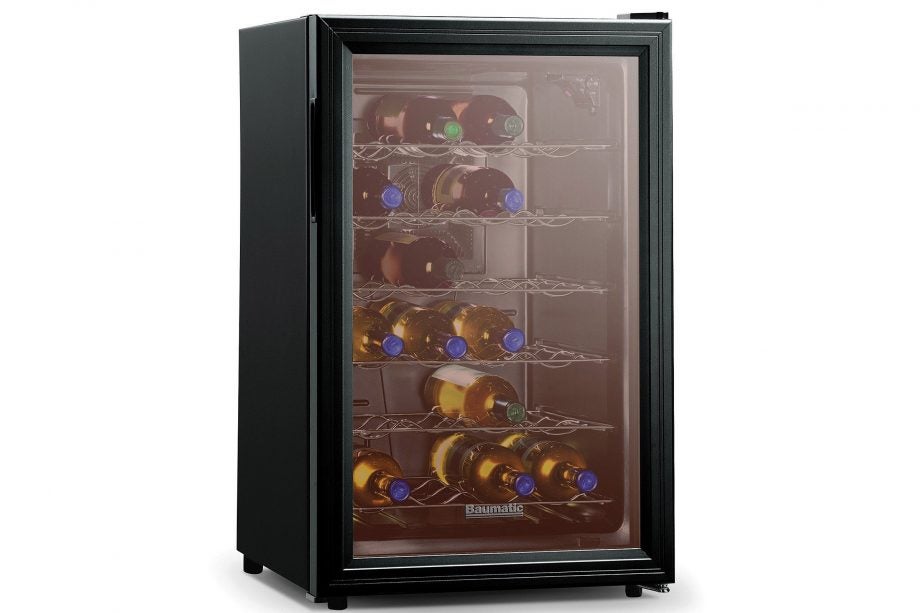
Verdict
Pros
- Consistent temperature throughout
- Good red wine conditioning
- Low vibration motor
- Good capacity for its size
Cons
- Limited to red wine temps
- High running costs
- Fiddly controls
- Quite noisy
Key Specifications
- Review Price: £169.00
- 28-bottle capacity
- B-rated energy efficiency
- 12-18ºC temp range
- Peltier (thermoelectric) motor
- Smoked glass door
- Interior LED light
- 2-year guarantee
What is the Baumatic BW28BL?
Baumatic makes a wide range of wine cabinets and beverage centres, with the 28-bottle BW28BL being almost its entry-level model at around £170. If you require storage for only 18 bottles, the BW18BL is a smaller option and £30-£40 cheaper. The BW28BL is nicely compact, has a vibration-free thermoelectric heat-pump motor and a full glass door.
That glass door is an odd gold colour that we couldn’t love, and the heat-pump motor is far from energy efficient. Its lowest setting is only 12ºC, rather limiting it to red wine, plus the interior light is woeful. Stable temperature throughout and lack of vibration are plus points for good wine conditioning, but running costs and design niggles limit its appeal.
Related: Best fridge freezer
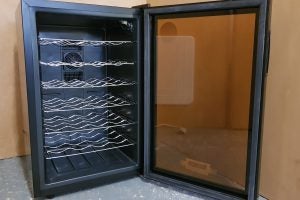
Baumatic BW28BL – Design and features
The BW28BL and its smaller sibling are quite unusual in that they don’t use traditional fridge compressors to chill your vino. They employ a thermoelectric cooler, otherwise known as a Peltier-effect heat pump.
For the technically minded, this is a large laminated plate of semiconductors that, when electricity is applied, draws heat from one side of the plate to the other.
On the plus side, the thermoelectric cooler is small and bolted onto the back of the appliance, rather than taking up valuable wine space. It’s also vibration-free, which is good for your wine, and virtually silent. The only operational noise is a small fan that cools the warm side of the heat pump and an internal fan that circulates the air.
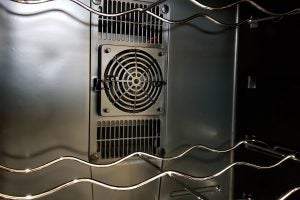
But let’s not get too excited about ‘heat pump’ energy efficiency here. Unlike tumble dryer heat pumps, small-scale thermoelectric coolers aren’t hugely efficient. As a humble 65-litre ‘fridge’, the BW28L scores an unhappy B-rating for energy efficiency.
And neither does it get very cold. The lowest temperature setting is a warm 12ºC, essentially limiting its wine-chilling abilities to reds. Okay, medium-bodied whites could be just about passable at this temperature, but 12ºC isn’t making the grade for white wine of any sort at Chez Stevenson. Red wine it is.
The cabinet itself is an innocuous satin-finished box measuring 46cm wide, 54 deep and 74cm tall. It has a full-size, double-glazed glass door with a light mirrored finish. This comes right-hand hinged and has an inset handle on the left edge.
Baumatic has drilled and tapped both sides of the cabinet for the hinges, technically making the opening reversible. However, the door handle can’t be swapped to the right side, which pretty much defeats the objective. Schoolboy error.
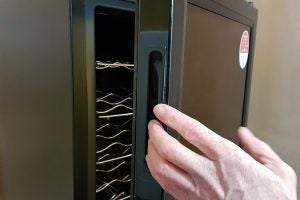
The glass is smoked and tinted with a distinctly yellow-brown colour. Light coming in from your kitchen and then reflected from the chrome racks make them look gold. Unless you have a kitchen with gold trims and brassware, that may well be a bit of bling too far. It certainly was for our tastes.
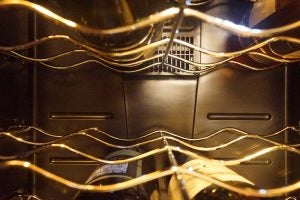
Theoretically, the interior of the cabinet is illuminated by a switchable on/off LED light. However, the one tiny, old-tech dome LED in the top right of the compartment has all the illuminating power of a candle. A small birthday cake candle at that. This is a picture of the BW28BL in the dark with the door open…
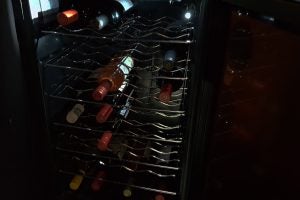
Close the door and the LED is all but invisible. However, being beside the control panel it shines right at you, making it difficult to see the thermostat knob. Thankfully, the LED can be switched off as it does nothing for showing off your wine through the smoked glass.
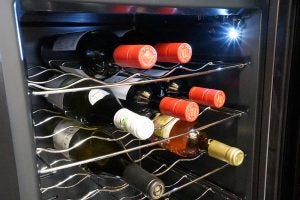
The thermostat itself is a tiny rotary knob with markings for high and low. If you want a precise temperature you’ll need a fridge thermostat and some trial and error. However, we did find that on the high setting the BW28BL hit around 11-12ºC and 18-19ºC on the low. It was a fairly linear progression in between, so you could have a good guess.
Operation is straightforward – insert wine, turn on, drink wine, repeat… – but we did have some teething issues with our sample.
It arrived from a retailer in a perfectly crisp box, yet the wine cooler had a smashed foot and the filter on the back needed bending out to stop the fan hitting it. Granted, both faults would have most buyers simply sending it back for a replacement, but it does rather suggest less than stellar build quality.
More perplexing was the ‘register your guarantee’ sticker on the door. That really, really didn’t want to come off.
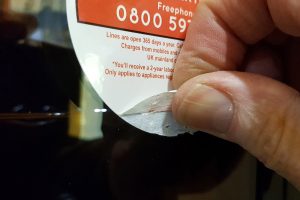
Baumatic BW28BL – How noisy is it?
Thermoelectric heat pumps are virtually silent since there are no moving parts. Heat is simply transferred from the inside of the cabinet to the outside of the thermoelectric plate. That, in turn, becomes hot so needs to be cooled with a fan, which makes a noise. There’s also an internal fan to circulate air, which makes noise too.
The Baumatic’s energy label suggests a super-silent 38dB, but we measured a fair bit more than that. With both the rear cooling fan and the interior fan running, it was outputting nearer 42dB. Given decibels are a logarithmic scale, that’s a whole lot louder than the claimed 38dB. It’s fairly noisy by current fridge standards and will be noticeable in a hushed kitchen.
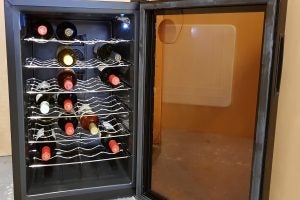
Baumatic BW28BL – How much can I get in it?
The BW28BK is a 28 bottle wine cooler. Given the relatively compact dimensions, that’s impressive capacity. The thermoelectric motor being on the back rather than in the base certainly frees up more bottle space, even if it means this cooler won’t go as far back to the wall.
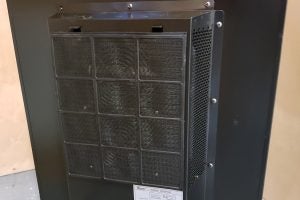
The storage is spaced over six chrome wire shelves and the floor of the compartment. You can get four bottles on each. Total, 28 bottles. Stock images of the BW28BL confusingly show the six wire racks taking up the whole of the cabinet space – which would actually make it a 24 bottle cooler. Go figure.
The disadvantage of pushing the wire racks closer together to free up that extra space on the floor is that it limits the height between racks. As a result, it only fits Bordeaux sized bottles of 77mm diameter comfortably. Step up to 83mm round bottles, such as Rhone area reds and often Chablis on the white side, and things get tight. You have to lift up the rack to get the bottle in and the rack then sits on the bottle. That’s snug and likely to result in scuffed labels.
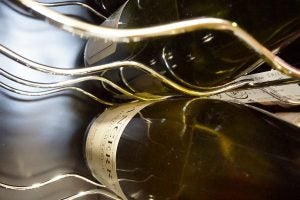
For extra space, you can remove any of the wire racks. This would offer storage space for cans at the bottom, for example. The racks don’t slide out with wine on them, though.
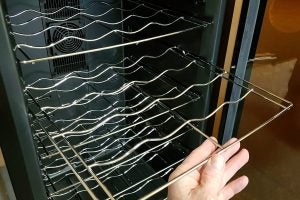
Baumatic BW28BL – Performance
Switched on the BW28BL takes a while to reach temperature. However, the slow-reacting motor means the internal temperature remains very stable. Nor does the temperature bounce around too much as the motor switches on and off. The internal fan wafts cool air around the cabinet, doing a remarkably good job at keeping the temperature uniform from top to bottom.
At its coolest setting (labelled ‘high’), the BW28BL ran at an average of 11.5ºC. Temperatures on the top rack, mid rack and on the floor of the compartment were almost identical. An excellent result. The variation during the motor cycle was just +/- 0.2ºC on all shelves. Along with the vibration-free motor, those are excellent environmental conditions for keeping your wine in tip-top order.
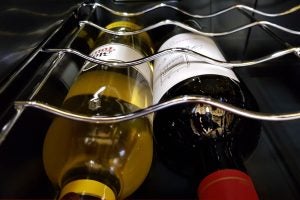
With the thermostat set mid-way on the dial, the average temperature crept up to around 15ºC. Again, the entire cabinet was a uniform temperature and the variation was minimal. For your medium-bodied reds, such as Merlot and Chianti, that’s ideal.
At its lowest setting the cabinet rose to around 18ºC. This is almost the same temperature as the environmental chamber we test in. Ironically, that meant the motor started less frequently, which resulted in a slightly higher fluctuation in the temperature stability. Mind you, we’re only talking +/- 0.5ºC, so still great conditions for your Cabernet Sauvignons and Syrahs.
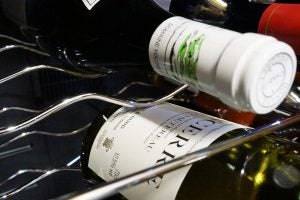
The BW28BL successfully delivers exceptionally stable and vibration-free storage for red wine, if you can forgive its electricity-hungry nature at cooler temperatures.
Baumatic BW28BL – How much will it cost to run?
Running costs are going to be very dependent on the temperature at which you set the BW28BL wine cooler. At its warmest 18-19ºC setting, the same as ambient, it sipped electricity. That is relative term, though.
Over a week-long period on this setting, it used 1.3kWh – or just shy of 20p at an average electricity cost of 15p/kWh. Over the year that would amount to just over a tenner. Good, but not much less than an A+ rated under-counter fridge with twice the capacity and much lower temperature.
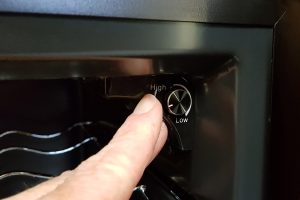
Running costs head rapidly north the lower you set the temperature. It’s a good job the BW28BL ‘only’ goes down to 12ºC, because it’s far from frugal. Running this temperature, it used nearer 3.5kWh over the course of a week’s testing under the same conditions. That amounted to a rather hefty 186kWh for a year, which is around £28 at the going rate.
Those figures tie up well with the energy label’s claimed 182kWh per annum. To put that into perspective, we’ve tested fridge freezers that use that sort of electricity over a year. So for the BW28BL’s compact 65-litre storage capacity and woeful high-lowest temperature, that’s seriously poor. So much for heat pump technology then.

Why buy the Baumatic BW28BL?
The BW28BL wine cooler offers a solid 28 bottle capacity in a neat and compact cabinet. The extra capacity is thanks to the vibration-free thermoelectric heat pump motor. Internal temperature is consistent throughout the cabinet and super-stable, resulting in a very good red wine conditioning environment. Only better air filtration could improve conditions further.
Yet the motor is far from efficient at a B energy rating, and doesn’t allow the cabinet to get any cooler than 12ºC. That’s fine for red wines, but way too warm for our white wine tastes.
In addition, at nearly £170 to purchase, with close to £30 per year running costs, this is far from a budget red wine storage solution. Compound that with pathetic internal lighting, slightly cramped shelves, noisy fans and the rather strange gold-tinted glass and things aren’t looking so great overall.
We find the BW28BL very difficult to heartily recommend, despite its very good wine conditioning credentials.
Verdict
The compact BW28BL offers vibration-free and consistent temperature wine storage, but high running costs and a 12ºC lowest temperature limit its appeal.


